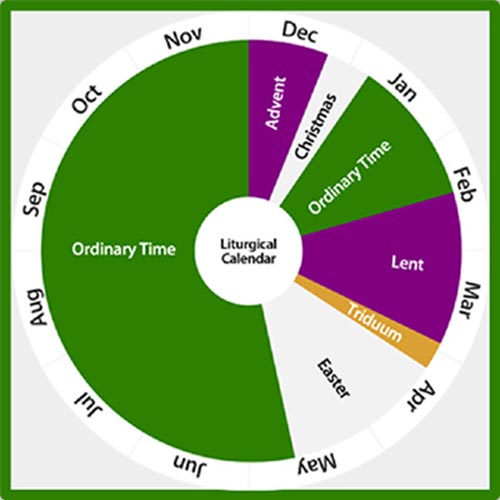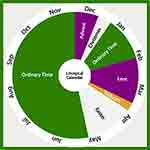
Sometimes you can patch together one great thing and another wonderful thing and make of the patched thing something appealing that works. At other times, when you patch two things together, you end up with a dog’s breakfast. When it comes to the calendar and lectionary for January and February, NZ Anglicanism has done the latter.
Before Vatican II, there were Sundays after Epiphany and Sundays after Trinity. Vatican II came up with a new system for organising the calendar and lectionary: start reading systematically on the Sunday that falls between 7 and 13 January, stop on Ash Wednesday, and start again after the Easter Season until Advent. It counted those 34 weeks as “Tempus Per Annum”.
Now, in English, we are perfectly comfortable to use Latin phrases such as et cetera, ad hoc, or alter ego… but somehow “Tempus Per Annum” is too much of a mouthful, “time during (or through) the year” didn’t make it, and the obscure “Ordinary Time” won (obscure because it’s not ordinary “ordinary”, it’s counting-as-in-‘ordinal numbers’ “ordinary”!).
The Church of England, more recently, came up with its own liturgical Brexit. It would start its “Ordinary Time” (no Latin there, thank you very much, we’re the Church of England!) in February rather than January.
NZ Anglicanism followed the wider Western church’s “Ordinary Time” numbering. But then, in a hankering after mother England, suddenly our church made “Ordinary Time” start in February. BUT – and here’s where NZ Anglicanism shows its creative uniqueness – we, here downunder, would call our first Sunday in February’s starting of Ordinary Time “The 4th (or even 5th – remember this is the Anglican Church of Or) Sunday in Ordinary Time”.
So, in NZ Anglicanism, there is no 1st, 2nd, nor 3rd Sunday in Ordinary Time – we leap straight in with “The 4th (or 5th) Sunday in Ordinary Time”.
Dog’s breakfast.
The first Sunday in NZ Anglicanism’s Ordinary Time is “The Fourth Sunday in Ordinary Time” or “The Fifth Sunday in Ordinary Time”. Only in NZ Anglicanism!
Here’s NZ Anglicanism’s unique sequence:
20 Jan: 2nd Sunday of the Epiphany
27 Jan: 3rd Sunday of the Epiphany
2 Feb: The Presentation of Jesus in the Temple
beginning of NZ Anglican Ordinary Time
3 Feb: The Presentation of Jesus in the Temple
Or 4th Sunday in Ordinary Time
10 Feb: 5th Sunday in Ordinary Time
I’m not even sure why we need these esoteric, badly-translated-from-the-Latin titles for these 34 Sundays and weekdays Tempus Per Annum. Why not simply refer to Sunday the 20th of January 2019? But that, my friends, would (obviously for some people) make religion, spirituality, and liturgy far too down to earth, too ordinary (see what I did there?). And surely if liturgy is to be liturgy it has to be arcane… beyond the easy accessibility of ordinary people…
If you appreciated this post, consider liking the liturgy facebook page, using the RSS feed, and/or signing up for a not-very-often email, …
Instagram’s @liturgy is the new venture – if you are on Instagram, please follow @liturgy.




Am I right that one part of the ancient intention of the liturgy itself and the Church calendar was to make the great events of the gospel story memorable even to worshippers who were illiterate? If so, we seem to have gone in the opposite direction by making things incomprehensible even to the literate.
I love it, Trevor! Tweet that & I’ll retweet it 🙂 Blessings.
I’m aware of just how wordy and obscure the words and layout of liturgy are, esp. when leading worship i find myself wanting to make it understandable and real life.
The minister talks on and on and the language is technical and doesn’t connect with the people.
Thanks, Rene. You echo what I say (especially in the video http://liturgy.co.nz/celebrating-eucharist) Liturgy is action accompanied by some explanatory words. Blessings.
Liturgically speaking, the time between the octave of the Epiphany and Septuagesima is an “Epiphany-tide”. Traditionally, the Cana wedding is read on the second Sunday after Epiphany, and Jesus’ encounter with the Gentile centurion on the third. So, it’s no “ordinary” time.
Also, traditionally, the liturgical colour is still white (only in Rome, they used green).
Of course, people can change the lectionaries and the collects etc. But those changes will never be authentic.
Thanks, George. The primary point of my post is NZ Anglicanism’s pasting together of two quite different approaches – conflicting, in fact. You are advocating for one tradition. What makes liturgy “authentic” and whether changes can be made by committees are wonderful discussions – but quite a lot bigger 🙂 Blessings.